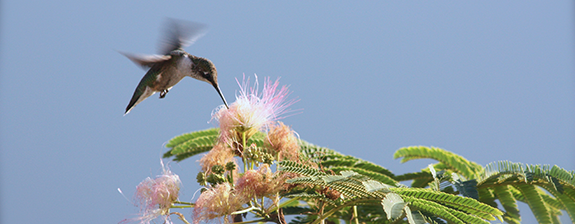
If the PDF of the article does not appear in your browser (this seems to be an issue in Safari, though not in Firefox), then choose 'Save As' to save the article as a PDF on your computer. You can then read the article there, using Adobe Acrobat or another PDF Reader
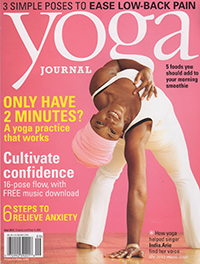 |
Primer on the Piriformis: Yoga Journal September 2012The piriformis is primarily an external rotator, one of a number of small, deep muscles that rotate the leg outward at the hip. It's notorious for causing sciatic pain. When the pinformis gets tight, it pinches the sciatic nerve and causes a burning pain at various points along the nerve's path, which runs from the buttock all the way down to the foot. Tightness in the piriformis also can bring hot pains in the buttock during hip stretches such Pigeon Pose and can affect forward bending...read more |
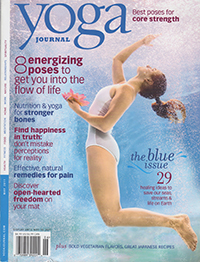 |
Beneath The Surface: Yoga Journal May 2011To achieve a toned and healthy midsection, you need to work with a number of muscles that are commonly called the "core." Your core includes more than just your abdominals muscles. Most exercises that target your abdominals can actually tighten the muscles around your tummy in such a way that they prevent abdominal tone and, if done without proper awareness, can push your belly out and even hurt your back. It's often the psoas that will cause you to lose the battle of the bulge. A key muscle at the very center of your core, the psoas is all too often overworked in ab exercises...read more |
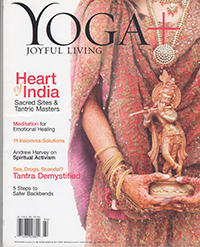 |
Better Backbends: Yoga+ Magazine Winter 2009-2010It would be hard to imagine yoga without backbends-they're invigorating, uplifting, and heart'opening. Backbends stimulate the proper functioning of the digestive system, help preserve the health of the vertebrae and spinal disks, and open the body to deep diaphragmatic breathing. It's no wonder that backbends are an important part of any hatha yoga routine. At the same time, these poses place strong demands upon the most vulnerable segment of the spine-the lumbar region. To protect against pinching in the low back, many teachers give cues to "scoop" or "tuck" the tailbone. But there's a better, more precise approach...read more |
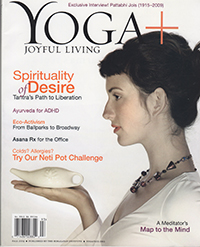 |
Sacroiliac Support: Yoga+ Magazine Fall 2009Do you experience stinging pain at the back of your pelvis on one side when you bend, |
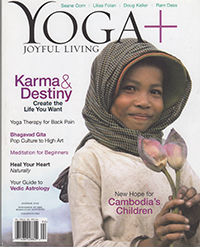 |
Deep Relief for Low Back Pain: Yoga+ Magazine Summer 2009While there are no quick fixes when it comes to low back pain, if you address the root of the problem, treatment can be surprisingly simple...In searching for a universal cause that could be directly linked to pain across various cases, researchers found that sufferers do share a common problem — an irregularity or weakness in the tiny back muscles called the multifidi. By understanding how these largely unacknowledged muscles work and targeting them with yoga therapy, you can find dependable relief from your low back pain...read more |
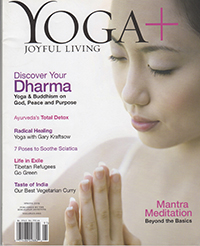 |
Sciatica: Yoga+ Magazine Spring 2009Sciatica has a long (and painful!) history. As far back as the 5th century BCE, doctors and sufferers alike have tried a host of imaginative remedies, from leeches and hot coals in Roman times to 20th-century use of creams and injections. The principle causes of sciatic pain are less mysterious than its heritage suggests, yet there are still millions who suffer from it. In 2005, the Journal of Neurosurgery: Spine estimated that more than 5 percent of the adult population in the United States suffers from sciatica...But here’s the good news: in many cases, a mindful, targeted yoga practice can help you overcome the pain...read more |
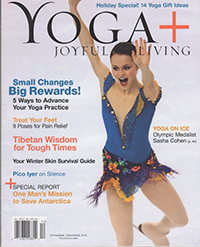 |
Bye Bye Bunions: Yoga+ Magazine November 2008A bunion is an all-too-common foot problem that can easily develop into a painful deformity if left unchecked. Medical science treats bunions as a progressive disorder and cites hereditary factors as the main culprit. But...constrictive shoes, coupled with the fact that we rarely stretch, massage, or otherwise properly exercise our feet, are also contributing factors. The good news is that a few warm-ups and exercises for the feet, along with targeted yoga poses, can slow the progression of bunions caused by hereditary factors, and even halt the formation of bunions resulting from neglect and ill-fitting shoes. Even if you don't have bunions, these exercises will reduce soreness and fatigue, and keep your feet healthy and strong...read more |
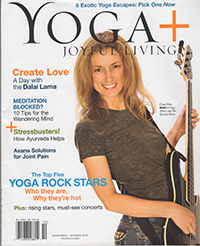 |
Recruit the Glutes: Yoga+ Magazine September 2008Did you know that you can simultaneously improve your posture, stabilize your knee and hip joints, and relieve your lower back pain by engaging the trio of muscles that make up the gluteals? Primary among these muscles is the under-appreciated "emperor" of postural integrity, gluteus maximus — along with his retinue of the deeper gluteal muscles: gluteus medius and gluteus minimus. These gluteals play a vital role in the health of our lumbar spine, sacrum, hip joints, and knees- when and if we use them properly...read more |
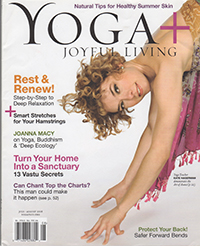 |
Relief for Tight Hamstrings: Yoga+ Magazine July 2008Those darn hamstrings. Their stubborn inflexibility is a source of frustration for many yoga practitioners, often because they know (or have heard) that forward bends would help their sore and stiff backs-if they could just get past their hamstrings. More than vanity is at stake here; lower back problems, hip problems, and knee problems can be traced, at least in part, to tight hamstrings. So why are the hamstrings so resistant to stretching? Three factors are worth considering: the anatomy of the muscles themselves, the postural habits of our well,heeled (shoe' wearing) culture, and counterproductive efforts to stretch them...read more |
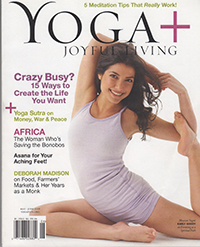 |
Yoga Therapy for Your Arches: Yoga+ Magazine May 2008Our cultural epidemic of weak and fallen arches provides a sure and steady income to the orthotics industry. But many of us still suffer from aches and pains that arch supports and padded insoles can’t quite eradicate. For instance, when you first hop out of bed in the morning, do you get a rude awakening from sore feet and tight calves? This is just one kind of soreness from chronic strain to a muscle whose job is to help lift the inner arch of your foot. Fallen arches can contribute to the development of bunions, shin splints, and pains in the knees and hips—and can even affect the lower back, neck, and shoulders...read more |
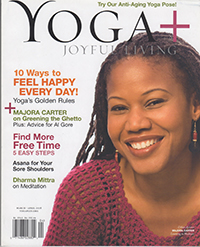 |
So Long Sore Shoulders!: Yoga+ Magazine March 2008Flexible ashtangis and other hatha yoga enthusiasts often suffer from dull, persistent pain at the fronts of the shoulders. Why? This type of soreness occurs when we overtax our shoulders in demanding poses such as chaturanga dandasana (four-limbed staff pose). If our shoulders are incorrectly positioned in such weight-bearing poses—and they often are—the tendons attaching the biceps to the fronts of the arm bones can be strained and may even begin to tear. This, in turn, may put strain on the rotator cuff, the group of muscles and tendons that stabilize the shoulder. Here are some tips to help you develop proper shoulder alignment...read more |
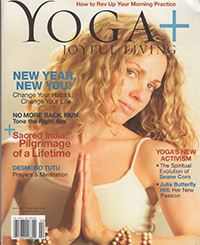 |
Abs to the Rescue: Yoga+ Magazine January 2008Did you know that the abdominal muscles are designed to protect the lumbar spine against disk problems? It’s a paradox then, that in our ab-obsessed culture, so many of us suffer from low back pain—and in particular, disk herniation among the lowest vertebrae. You might think that toning your abs would lead to fewer back problems, but unfortunately, that is often not the case. Sit-ups and related exercises strengthen only one set of abdominal muscles, the rectus abdominis, which have little to do with the health of your spine...read more |
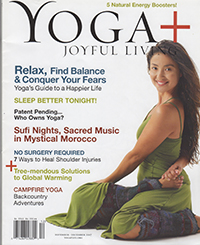 |
How to Prevent Shoulder Injuries: Yoga+ Magazine November 2007Each time you lift your arms, your shoulder muscles-both big and small-initiate a dance full of subtle nuances. The complex interaction of those muscles, coupled with the unique structure of the shoulder joint, gives your arms a wide range of motion. In fact, the shoulder is one of the loosest joints in the body. But this freedom of movement comes at a price: shoulders are vulnerable to injury both from sudden falls and from repetitive action such as throwing a baseball. But here's the good news: a regular, targeted asana practice can help you maintain healthy rotator cuffs by bringing awareness to your alignment, strengthening your shoulder muscles, and opening your chest...read more |
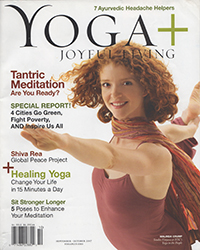 |
Sole Support — Your Arches: Yoga+ Magazine September 2007In the Vedas, the feet are referred to as "organs of action." They are the body's foundation, structured to support its weight and provide a mobile platform in a variety of terrains. A weak foundation in your feet creates problems in your legs, knees, hips, back, shoulders, and neck, causing muscle tension, postural imbalances, and fatigue. Your feet are mirrors for the rest of the body. If you're holding tension in your feet right now, you're probably holding tension in other parts of your body, too. And when your feet are tired, your entire body is tired. This explains, in part, why yoga practitioners devote so much attention to the position, alignment, and distribution of weight through the feet...read more |
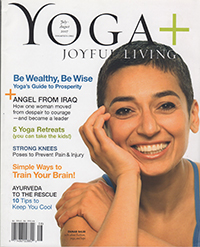 |
Yoga Therapy for Your Knees: Yoga+ Magazine July 2007If you have chronic pain in your knees, if they "snap, crackle, and pop" when you bend or extend them, or it they tend to hyperextend, you may have improper tracking or "dislocation” of the kneecap. This misalignment causes the most common kind of chronic knee pain and damage to the knee joint. The kneecap is designed to slide along a groove in the femur; if it goes "off track,", it grinds away at the cartilage underneath. This wear and tear is a key reason for knee replacement surgery... If we don't correct the imbalanced pull of muscles on the kneecap, we will continue to grind our cartilage down faster than our body can replenish it...read more |
 |
Lower Back Blues: Yoga+ Magazine May 2007Why do so many of us suffer from lower back pain? More often than not, it's because we spend most of our waking hours sitting-and that isn't healthy. One of the side effects of sitting all the time can be a shortened psoas muscle, which can pull on (and even twist) the spine, causing lower back pain. By working with this often overlooked muscle, we can undo a major cause of our discomfort. Yoga is well suited to this task; but before we see what it has to offer, we need to know where the psoas is, what it does, and what problems it causes when it is tight or dysfunctional...read more |
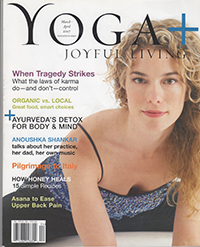 |
Upper Back Pain: Yoga+ Magazine March 2007One of the most common problems my yoga students complain about is chronic pain around the shoulder blades and in the upper back and neck. This kind of pain plagues those of us who work with our arms extended in front of us, whether we’re typing on the computer, cooking, carrying children, lifting heavy objects, or washing dishes. Let’s face it: that includes just about all of us. Because these activities are especially demanding on the arms, shoulders, and upper back, it’s not surprising that back pain is so widespread, even among the most dedicated yoga students...read more |
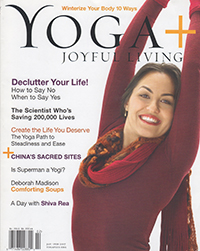 |
Healing (and Preventing)Wrist Injuries: Yoga+ Magazine January 2007Few things put the brakes on a yoga practice like a wrist injury. And though it may seem like the injury is the result of your practice, the cause actually lies in the imbalanced way we use our wrists in daily life. Once we become aware of these imbalances, asana practice can become a powerful tool for correcting them. The health of our wrists depends upon the strength and tone of the muscles on the tops and bottoms of our forearms, as well as upon how thoughtfully we bear weight on our hands and wrists...read more |
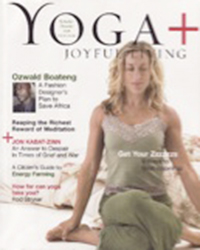 |
Healing Hamstring Injuries: Yoga+ Magazine November 2006Ask any room of yoga students whether they suffer from pain at one or both of their sit bones, and you can count on a showing of hands. This kind of pain comes from injury to the hamstring attachment. Of course, hamstring injuries are not unique to yoga, though the cause and treatment of this particular problem often is. The more dramatic hamstring tears occur in sports and especially while running, when athletes are tightly wound and move in sudden bursts that wrench and tear at the hamstrings, usually in the “belly,” or middle part, of the muscle. In yoga, the injury occurs in a different way and at a different place...read more |
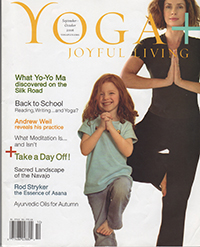 |
Resolvlng Neck Tension: Yoga+ Magazine September 2006When we carry ourselves with the head thrust forward, we create neck pain, shoulder tension, even disc herniation and lower back problems. A reliable cue to remind ourselves how to shift the head back into a more stress-free position would do wonders for resolving these problems, but first we have to know what we're up against. When it comes to keeping our head in the right place, the neck is at something of a disadvantage. There are a number of forces at work that can easily pull the neck into misalignment, but only a few forces that maintain the delicate alignment of the head on the spine...read more |
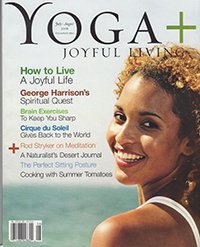 |
Overcoming Hip Pain: Yoga+ Magazine July 2006The confluence of a few simple factors can create a perfect storm of stress in the hip joint, especially for those leading an active life: joggers, walkers, weekend athletes, and, of course, asana practitioners. To understand the problem, we’ll look at two important sets of muscles: the adductors (muscles of the inner thigh and groin that draw the legs toward the midline of the body) and the abductors (muscles of the outer hip that move the thighs apart, away from the midline)...read more |
